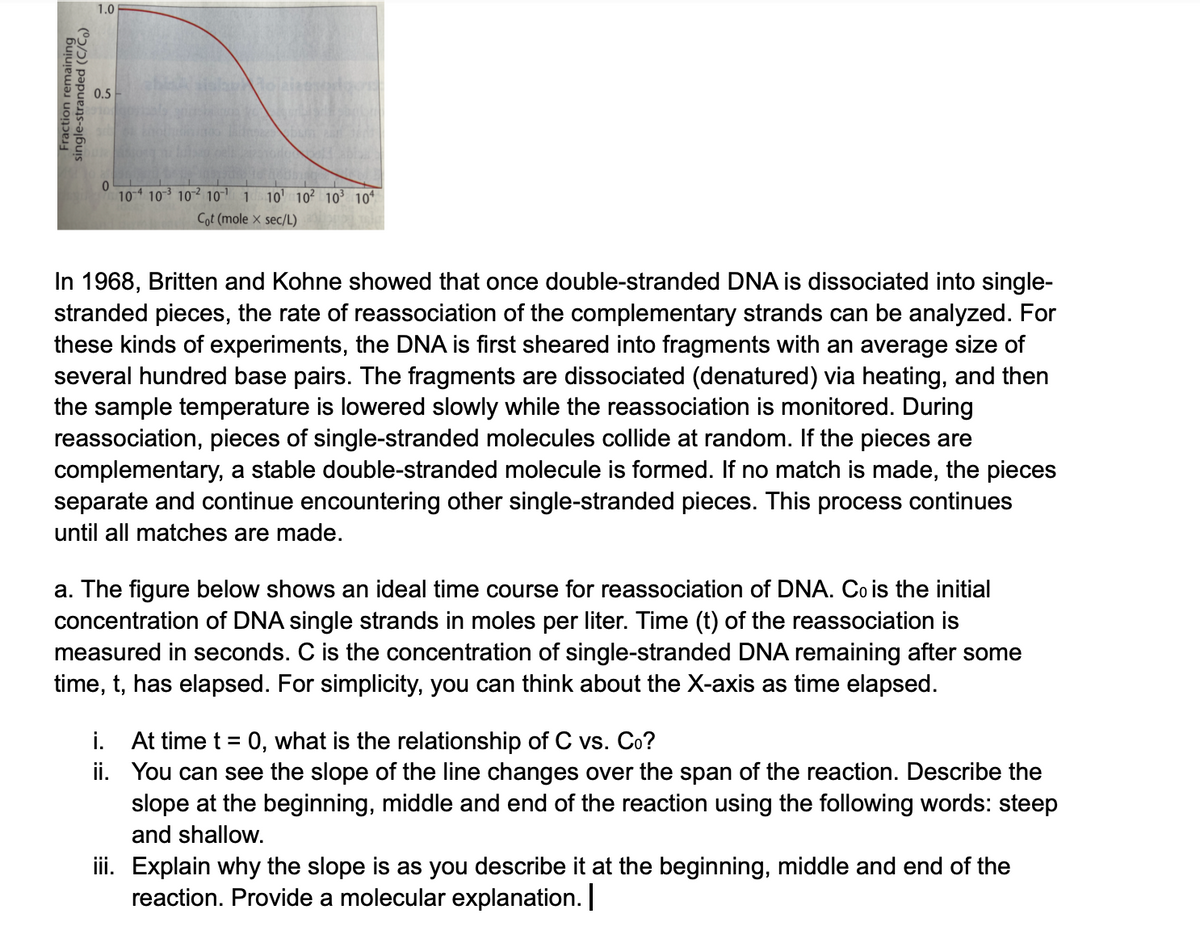Human Heredity: Principles and Issues (MindTap Course List)
11th Edition
ISBN:9781305251052
Author:Michael Cummings
Publisher:Michael Cummings
Chapter8: The Structure, Replication, And Chromosomal Organization Of Dna
Section: Chapter Questions
Problem 14QP: State the properties of the WatsonCrick model of DNA in the following categories: a. number of...
Related questions
Question
Please help.I am stuck

Transcribed Image Text:0.5
104
10 102 10 1 10' 10² 103³ 10*
Cot (mole × sec/L)
In 1968, Britten and Kohne showed that once double-stranded DNA is dissociated into single-
stranded pieces, the rate of reassociation of the complementary strands can be analyzed. For
these kinds of experiments, the DNA is first sheared into fragments with an average size of
several hundred base pairs. The fragments are dissociated (denatured) via heating, and then
the sample temperature is lowered slowly while the reassociation is monitored. During
reassociation, pieces of single-stranded molecules collide at random. If the pieces are
complementary, a stable double-stranded molecule is formed. If no match is made, the pieces
separate and continue encountering other single-stranded pieces. This process continues
until all matches are made.
a. The figure below shows an ideal time course for reassociation of DNA. Co is the initial
concentration of DNA single strands in moles per liter. Time (t) of the reassociation is
measured in seconds. C is the concentration of single-stranded DNA remaining after some
time, t, has elapsed. For simplicity, you can think about the X-axis as time elapsed.
i. At time t = 0, what is the relationship of C vs. Co?
ii. You can see the slope of the line changes over the span of the reaction. Describe the
slope at the beginning, middle and end of the reaction using the following words: steep
and shallow.
iii. Explain why the slope is as you describe it at the beginning, middle and end of the
reaction. Provide a molecular explanation.
Expert Solution
This question has been solved!
Explore an expertly crafted, step-by-step solution for a thorough understanding of key concepts.
This is a popular solution!
Trending now
This is a popular solution!
Step by step
Solved in 4 steps

Knowledge Booster
Learn more about
Need a deep-dive on the concept behind this application? Look no further. Learn more about this topic, biology and related others by exploring similar questions and additional content below.Recommended textbooks for you

Human Heredity: Principles and Issues (MindTap Co…
Biology
ISBN:
9781305251052
Author:
Michael Cummings
Publisher:
Cengage Learning

Concepts of Biology
Biology
ISBN:
9781938168116
Author:
Samantha Fowler, Rebecca Roush, James Wise
Publisher:
OpenStax College

Human Heredity: Principles and Issues (MindTap Co…
Biology
ISBN:
9781305251052
Author:
Michael Cummings
Publisher:
Cengage Learning

Concepts of Biology
Biology
ISBN:
9781938168116
Author:
Samantha Fowler, Rebecca Roush, James Wise
Publisher:
OpenStax College